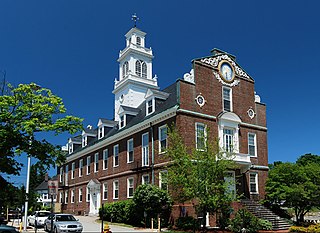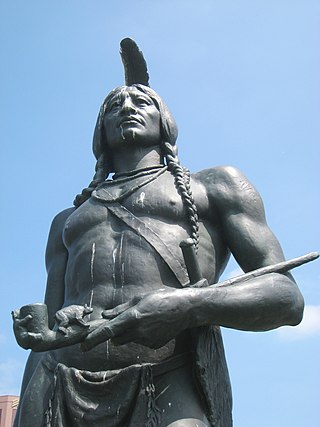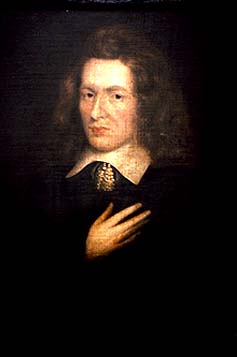
Myles Standish was an English military officer and colonist. He was hired as military adviser for Plymouth Colony in present-day Massachusetts, United States by the Pilgrims. Standish accompanied the Pilgrims on the ship Mayflower and played a leading role in the administration and defense of Plymouth Colony from its foundation in 1620. On February 17, 1621, the Plymouth Colony militia elected him as its first commander and continued to re-elect him to that position for the remainder of his life. Standish served at various times as an agent of Plymouth Colony on a return trip to England, as assistant governor of the colony, and as its treasurer.

The Massachusetts Bay Colony (1628–1691), more formally the Colony of Massachusetts Bay, was an English settlement on the east coast of North America around the Massachusetts Bay, one of the several colonies later reorganized as the Province of Massachusetts Bay. The lands of the settlement were in southern New England, with initial settlements on two natural harbors and surrounding land about 15.4 miles (24.8 km) apart—the areas around Salem and Boston, north of the previously established Plymouth Colony. The territory nominally administered by the Massachusetts Bay Colony covered much of central New England, including portions of Massachusetts, Maine, New Hampshire, and Connecticut.

Plymouth Colony was the first permanent English colony in New England from 1620 and the third permanent English colony in America, after Newfoundland and the Jamestown Colony. It was settled by the passengers on the Mayflower at a location that had previously been surveyed and named by Captain John Smith. The settlement served as the capital of the colony and developed as the town of Plymouth, Massachusetts. At its height, Plymouth Colony occupied most of the southeastern portion of Massachusetts. Many of the people and events surrounding Plymouth Colony have become part of American folklore, including the American tradition of Thanksgiving and the monument of Plymouth Rock.

Weymouth is a city in Norfolk County, Massachusetts, United States. It is one of 13 municipalities in the state to have city forms of government while retaining "town of" in their official names. It is named after Weymouth, Dorset, a coastal town in England, and is the second-oldest settlement in Massachusetts, second only to Plymouth. It is one of the South Shore's more affordable towns and offers a short commute into Boston, MBTA bus and rail service, and a town beach.

Tisquantum, more commonly known as Squanto, was a member of the Wampanoag Patuxet tribe best known for being an early liaison between the Native American population in Southern New England and the Mayflower Pilgrims who made their settlement at the site of Tisquantum's former summer village, now Plymouth, Massachusetts. The Patuxet tribe had lived on the western coast of Cape Cod Bay, but an epidemic infection wiped them out, likely brought by previous European explorers.

Massasoit Sachem or Ousamequin was the sachem or leader of the Wampanoag confederacy. Massasoit means Great Sachem. Massasoit was not his name but a title. English colonists mistook Massasoit as his name and it stuck.

Edward Winslow was a Separatist and New England political leader who traveled on the Mayflower in 1620. He was one of several senior leaders on the ship and also later at Plymouth Colony. Both Edward Winslow and his brother, Gilbert Winslow signed the Mayflower Compact. In Plymouth he served in a number of governmental positions such as assistant governor, three times was governor and also was the colony's agent in London. In early 1621 he had been one of several key leaders on whom Governor Bradford depended after the death of John Carver. He was the author of several important pamphlets, including Good Newes from New England and co-wrote with William Bradford the historic Mourt's Relation, which ends with an account of the First Thanksgiving and the abundance of the New World. In 1655 he died of fever while on an English naval expedition in the Caribbean against the Spanish.

Josiah Winslow was the 13th Governor of Plymouth Colony. In records of the time, historians also name him Josias Winslow, and modern writers have carried that name forward. He was born one year after the Charter which founded the Massachusetts Bay Colony, bringing over 20,000 English immigrants to New England in the 1630s. Josiah was the Harvard College-educated son of Mayflower passenger and Pilgrim leader and Governor Edward Winslow and was Governor from 1673 to 1680. The most significant event during his term in office was King Philip's War, which created great havoc for both the English and Indian populations and changed New England forever. Josiah was the first governor born in a "New England" colony.

Peregrine White was the first baby boy born on the Pilgrim ship the Mayflower in the harbour of Massachusetts, the second baby born on the Mayflower's historic voyage, and the first known English child born to the Pilgrims in America. His parents, William White and his pregnant wife Susanna, with their son Resolved White and two servants, came on the Mayflower in 1620. Peregrine White was born while the Mayflower lay at anchor in the harbor at Cape Cod. In later life he became a person of note in Plymouth Colony, active in both military and government affairs.
Francis West was a Deputy Governor of the Colony and Dominion of Virginia.
Samuel Maverick was one of the first colonists to settle in the Massachusetts Bay Colony. Arriving ahead of the Winthrop Fleet, Maverick became one of the earliest settlers, one of the largest landowners and one of the first slave-owners in Massachusetts. He signed his name as "Mavericke". He is the ancestor of rancher Samuel Maverick, from whom the term maverick for "independently minded" and an unbranded animal derives.
Thomas Morton was an early colonist in North America from Devon, England. He was a lawyer, writer, and social reformer known for studying American Indian culture, and he founded the colony of Merrymount, located in Quincy, Massachusetts.

Captain Christopher Levett was an English writer, explorer and naval captain, born at York, England. He explored the coast of New England and secured a grant from the king to settle present-day Portland, Maine, the first European to do so. Levett left behind a group of settlers at his Maine plantation in Casco Bay, but they were never heard from again. Their fate is unknown. As a member of the Plymouth Council for New England, Levett was named the Governor of Plymouth in 1623 and a close adviser to Capt. Robert Gorges in his attempt to found an early English colony at Weymouth, Massachusetts, which also failed. Levett was also named an early governor of Virginia in 1628, according to Parliamentary records at Whitehall.
Robert Gorges was a captain in the Royal Navy and briefly Governor-General of New England from 1623 to 1624. He was the son of Sir Ferdinando Gorges. After having served in the Venetian wars, Gorges was given a commission as Governor-General of New England and emigrated to modern Weymouth, Massachusetts, in 1623, building his settlement on the site of the failed Wessagusset Colony.
Richard Greene was the first Governor of Wessagusset Colony in New England, located in modern-day Weymouth, Massachusetts. He died at Plymouth colony after having only governed the ill-fated Wessagusset colony for a few months since its creation in July. He was the brother-in-law of Thomas Weston, the primary investor in the colony.

Chickatawbut was the sachem, or leader, of a large group of indigenous people known as the Massachusett tribe in what is now eastern Massachusetts, United States, during the initial period of English settlement in the region in the early seventeenth century.

Resolved White was a passenger on the Pilgrim ship Mayflower. In 1620, he accompanied his parents, Pilgrims William and Susanna White, on the journey. He married Judith Vassall, daughter of William Vassall, a founder of the Massachusetts Bay Colony. Later in life White became a notable person of Plymouth Colony.
Also see: The ships Anne and Little James

Phineas Pratt, a joiner from London, was one of the first English settlers in New England and enrolled among the "First Comers" of Plymouth Colony. Pratt arrived as part of the company of Thomas Weston on the 1622 voyage of the ship Sparrow and was among the founders of the Wessagusset (Weymouth) settlement which failed in March 1623. In 1623, when it still numbered about 32 dwellings, Pratt joined the Plymouth Colony and later married Mary Priest, the daughter of Mayflower passenger Degory Priest. In 1662, he wrote an account of the early days of the Wessagusett colony as part of a petition to the General Court of Massachusetts for "First Comer" status, which he was granted.
















